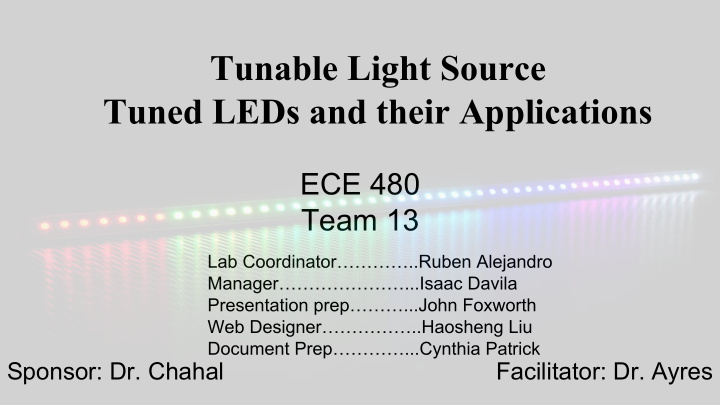



Tunable Light Source Tuned LEDs and their Applications ECE 480 Team 13 Lab Coordinator…………..Ruben Alejandro Manager…………………...Isaac Davila Presentation prep………...John Foxworth Web Designer……………..Haosheng Liu Document Prep…………...Cynthia Patrick Sponsor: Dr. Chahal Facilitator: Dr. Ayres
Table of Contents ● LEDs ● Coding ● Optics - Lens ● Applications: ○ Jaundice ○ Plant Growth
Project Goals ● Create a tunable light source that emulates the black body radiation curve of the sun. ● To be used in solar cell testing, and has potential to be used in a variety of other applications. ● Design is to be low cost, adaptable, and user friendly.
Final Schematic PMW PMW PMW
LED
What is an LED? ● Light-emitting diode ○ Semiconducting material ○ Impurities P-N junction ○ ■ p-type ■ n-type
How LED works? ● P-type semiconductor ● N-type semiconductor ● Electron ● Hole ● Photon
What determine the color of light? ● Frequency ● Band gap energy ○ conduction band Valence band ○ ● Photon energy released
LED Spectrum
Recreating a Spectrum Output ● Only interested in 400nm - 1100nm ● Utilize digital approximations to store graph data ● Export graph data as an array to be interpreted by program
Recreating a Spectrum Output (cont.) ● Each point will represent one LED relative power output ● Power will be adjusted using PWM ● Summation of all data points will give a close approximation
analogWrite(Pin, Value) • Allows us to assign intensity values to each LED separately • Given enough data points, can accurately recreate an intensity vs. wavelength graph • Can be updated within the code in real time.
Coding ● Simplicity allows int i = 1; flexibility // declares an array of integers int[] value; ● Array can be created // allocates memory for 25 integers value = new int[25] from multiple sources. // Continuously updates output ● Array values can be while (i < 26) { updated at any time. analogWrite(i,value[i]; i++; } i=1;
Optics
Optics ● Optics explains the phenomena of electromagnetic waves. ● Infrared, ultraviolet, and visible light. ● It also studies the construction of the instruments used to detect it
Optics ● Optics is usually studied in two practical modes: ○ Geometric optics ■ treats light as a collection of rays that travel in a straight path and bend as they encounter a surface. ○ Physical optics ■ treats the electromagnetic spectrum as a comprehensive model of light.
Lenses (Optics) ● Lens ○ made out of transparent material ○ optical instrument ■ focusing of light through reflection and refraction ■ can diverge or converge light
Lenses ● Different types of Lenses
Lenses Applied ● Lenses will be used to focus the light ○ Consider for LED radiation ■ does not operate as a laser beam ● makes it harder to focus ■ Need an alternative ● Housing ● Fiber Optic Cable
Fiber Optic Cable ● Fiber optic cable ○ Is able to bend light ○ is going to output a narrow beam ■ may not be as straight as desired
Housing ● Reflective housing ○ To reflect light ■ Set it to a straight pattern
Jaundice Treatment
● Developed by 60% of Newborns ● Caused by a buildup of the chemical Bilirubin ● There is an extremely wide variety of causes including: ○ Chemicals in breast milk ○ The liver not yet mature ○ Collection of blood under scalp ○ Incompatible blood type
How it presents itself ● Yellowing of the skin ● Can cause ○ Brain damage ○ Hearing loss ○ Physical abnormalities ○ Death
● When exposed to blue light Bilirubin breaks down ● Typical severe Jaundice level of Bilirubin is 20 mg/dL ● More critical cases require a higher frequency of blue light than less extreme cases. ● Customization of frequency has led to a decrease in treatment time
● Customization of intensity can also increase effectiveness of treatment ● When less melanin is present more blue light will be reflected away from the skin
● Our design can be applied by: ○ Creating a blue LED array ○ Adjusting our lenses ○ Same programming with different GUI
Plant Growth
Photosynthesis How plants produce food
Photosynthetic Pigments ● Absorb and Reflect Light ● Major Pigments o chlorophyll (green) Range 400nm to 700nm o carotenoids
Absorption Spectrum ● Pigment’s Light Absorption vs Wavelength
Project Relevance Apply to Greenhouses/ Indoor Growing Tweak our Design to output only the wavelengths needed for Photosynthesis (plant growth)
Control over Growth Stages Red Light(650 nm > λ < 750 nm) induce Flowering Stage Blue (λ < 450nm) induce Vegetative Stage (plant growth)
Conclusion ● Low Cost ● Minimal Power Consumption ● Tunable Design
Questions?
Recommend
More recommend